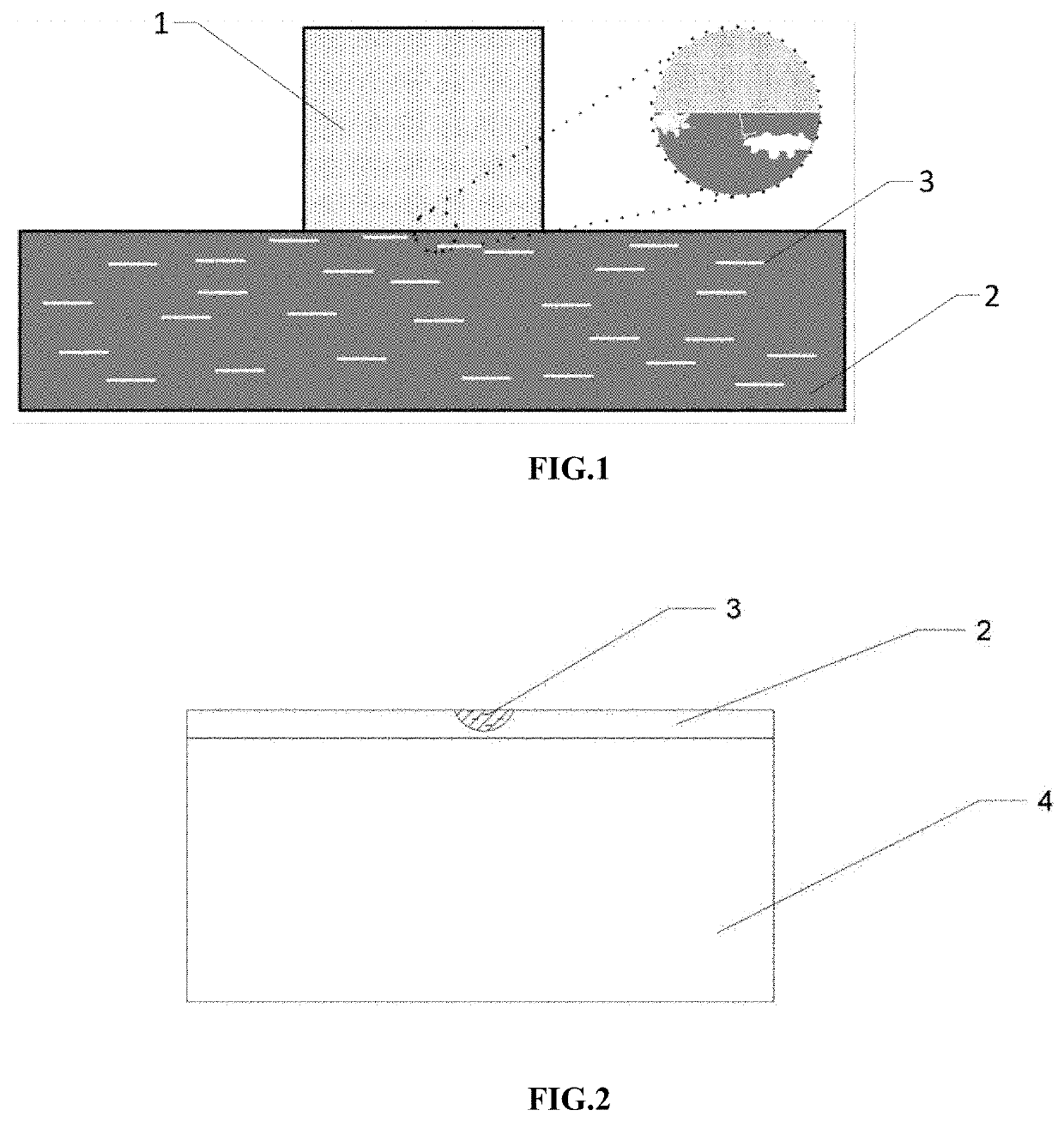Intelligent Anti-icing material and preparation method and use thereof
a technology of intelligent anti-icing material and preparation method, which is applied in the field of composite materials, can solve the problems of affecting the production and life of people,
- Summary
- Abstract
- Description
- Claims
- Application Information
AI Technical Summary
Benefits of technology
Problems solved by technology
Method used
Image
Examples
example 1
[0050]The heat treatment was performed as follows: a nickel-titanium alloy wire with a diameter of 150 μm and a length of 0.3 cm (with a composition of Ti-50.8Ni) was annealed at 650° C. for 25 minutes, water quenched, and then kept at 300° C. for 24 hours, obtaining a nickel-titanium alloy wire with a martensite transformation point temperature of −30 to −10° C.
[0051]The pretreatment was performed as follows: the heat-treated nickel-titanium alloy wire was washed and sonicated in acetone at 100 Hz for 30 minutes, washed with distilled water, and washed in a mixed solution of hydrofluoric acid, nitric acid and water with a volume ratio of 1:5:2 for 30 seconds, and blown to dry with N2.
[0052]The intelligent anti-icing material was prepared as follows: the pretreated nickel-titanium alloy wire was immersed in Piranha solution, at 90° C. for 3 minutes; the resulting mixture was subjected to a suction filtration, washed with distilled water and dried, obtaining a hydroxylated nickel-tit...
example 2
[0053]The heat treatment was performed as follows: a nickel-titanium alloy wire with a diameter of 80 μm and a length of 0.3 cm (with a composition of Ti-58.6Ni) was annealed at 450° C. for 120 minutes, air-cooled, and then kept at 400° C. for 24 hours, obtaining a nickel-titanium alloy wire with a martensite transformation point is temperature of −30 to −10° C.
[0054]The pretreatment was performed as follows: the heat-treated nickel-titanium alloy wire was washed and sonicated in acetone at 100 Hz for 30 minutes, washed with distilled water, and washed with a mixed solution of hydrofluoric acid, nitric acid and water with a volume ratio of 1:5:2 for 15 seconds, and blown to dry with N2.
[0055]The intelligent anti-icing material was prepared as follows: the pretreated nickel-titanium alloy wire was immersed in Piranha solution, at 90° C. for 1.5 minutes; the resulting mixture was subjected to a suction filtration, washed with distilled water and dried, obtaining a hydroxylated nickel-...
use example 1
[0056]The intelligent anti-icing material obtained in Example 1 was laid on the surface of polypropylene resin (matrix resin plate), and hot pressed at 1 MPa and 180° C. for 40 minutes, obtaining an anti-icing composite material. FIG. 2 shows a schematic diagram of Use Example 1 of the present disclosure. In FIG. 2, 2 represents a resin, 3 represents a nickel-titanium alloy wire, and 4 represents a matrix resin plate.
[0057]The obtained anti-icing composite material was tested as follows: a tester for the adhesion of the ice layer was set up, and the stage was cooled and maintained at −20° C. (freezing temperature) with a constant temperature circulating cooling box, with an ice-pushing rate of 1 mm / s; the adhesion of the ice layer was characterized by the shear strength required to push down the icicle.
[0058]The test result shows that the adhesion of the ice layer was 54 kPa.
PUM
| Property | Measurement | Unit |
|---|---|---|
| transformation point temperature | aaaaa | aaaaa |
| diameter | aaaaa | aaaaa |
| length | aaaaa | aaaaa |
Abstract
Description
Claims
Application Information
 Login to View More
Login to View More - R&D
- Intellectual Property
- Life Sciences
- Materials
- Tech Scout
- Unparalleled Data Quality
- Higher Quality Content
- 60% Fewer Hallucinations
Browse by: Latest US Patents, China's latest patents, Technical Efficacy Thesaurus, Application Domain, Technology Topic, Popular Technical Reports.
© 2025 PatSnap. All rights reserved.Legal|Privacy policy|Modern Slavery Act Transparency Statement|Sitemap|About US| Contact US: help@patsnap.com

